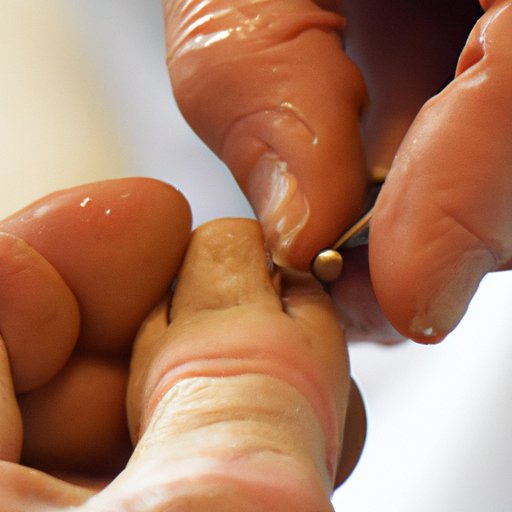
I. Introduction
Ingrown toenail is a common problem faced by many people, causing discomfort, pain, and even infection. It occurs when the edge of the toenail grows into the surrounding skin, often the big toe. This condition can be extremely painful and can make wearing shoes agony. In this article, we will explore different ways of curing ingrown toenails.
II. What Causes Ingrown Toenails and How to Treat Them
Ingrown toenails are commonly caused by improper nail trimming, poor foot hygiene, or ill-fitting shoes. Additionally, certain medical conditions such as arthritis, diabetes, or fungal infections can contribute to this problem.
The symptoms of ingrown toenails include pain, swelling, redness, and sometimes even pus or drainage from the affected area. If left untreated, it can lead to severe pain and a possible bacterial infection, which requires proper treatment.
First-aid treatment for ingrown toenails begins with soaking the affected toe in warm water for around fifteen minutes. The water should be as hot as can be tolerated and should be changed every 15 to 20 minutes. After soaking, dry your foot and wear comfortable shoes. Avoid wearing tight shoes or socks, as this can worsen the problem.
III. The Dos and Don’ts of Treating an Ingrown Toenail
Proper nail trimming is an essential aspect of preventing the development of ingrown toenails. When trimming, ensure that you cut your nails straight across and do not round the edges. Use clean trimming equipment and avoid cutting too low into the sides of the nails.
It is essential to keep the affected area clean, and to achieve this, soak the foot in warm saltwater. After soaking, try to keep the area dry and moisturized.
It is important to avoid using any sharp objects or unsanitary methods to treat ingrown toenails, as this can lead to further infections, cuts or wounds.
IV. “5 Home Remedies to Cure Ingrown Toenail Naturally”
Here are some natural remedies that you can try at home to cure ingrown toenail:
- Apple Cider Vinegar: Soak a cotton ball in apple cider vinegar and hold it onto the affected area. The acidic properties of vinegar soften the nail and relieve pain.
- Epsom Salt Soaks: Epsom salt can ease pain and reduce inflammation due to the magnesium content. Soak your feet in warm water with Epsom salts for 20-30 minutes twice a day.
- Tea Tree Oil: The topical application of pure tea tree oil has anti-inflammatory and antiseptic properties that can effectively treat ingrown toenails.
- White Vinegar Soaks: Dilute enough white vinegar in warm water enough to soak in your feet for 20-30 minutes twice a day. It softens the nail and relieves pain.
- Toenail Mint Paste: Mix mint leaves with Aloe Vera gel and apply the mixture directly onto your ingrown toenails. The wonderful cooling benefits of mint soothe the inflammation of the toe.
V. Relieving Pain from Ingrown Toenails: A Step-by-Step Guide
Here is a step-by-step guide on how to relieve pain from ingrown toenails:
- Clean the affected area with soap and water.
- Apply a topical antibiotic and cover the area with a band-aid or sterile gauze to keep it clean and avoid pressure from the shoes.
- Wear comfortable shoes that do not pinch or put pressure on the toe.
- Soak the foot in warm, soapy water for around 20-30 minutes a few times a day.
- Massaging the affected area gently can also offer relief from pain.
VI. Ingrown Toenail Treatment: Surgery vs. Non-Surgical Options
If the symptoms of the ingrown toenail persist or worsen, professional medical treatment may be necessary. The removal of the toenail is an option for severe cases that don’t respond to other treatments. Nail avulsion under local anesthesia is the surgical procedure used to remove the toenail.
Non-surgical options for treating ingrown toenails include treatments such as antibiotic soaks, topical and oral antibiotics, and wound dressings. The non-surgical option usually works best for mild to moderate ingrown toenails.
VII. Preventing Ingrown Toenails: Tips and Tricks for Healthy Feet
Here are some tips and tricks to help you prevent ingrown toenails:
- Properly trim your toenails, cutting straight across and not too short.
- Wash and dry your feet regularly.
- Wear comfortable shoes that fit properly.
- Avoid wearing tight socks or stockings.
- For athletes, it is important to wear proper-sized shoes and wear protective gear to avoid direct hits on the feet.
VIII. Conclusion
Ingrown toenails can be excruciating, causing discomfort, pain, and even infection. Proper nail care, cleanliness, and wearing comfortable shoes can help prevent ingrown toenails. If you experience severe or persistent pain, redness, or other signs of infection, seek medical attention as soon as possible. This article explored ways to naturally cure ingrown toenails, relieve pain, and prevent the condition from developing in the future.





